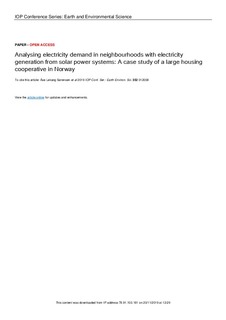| dc.contributor.author | Sørensen, Åse Lekang | |
| dc.contributor.author | Sartori, Igor | |
| dc.contributor.author | Lindberg, Karen Byskov | |
| dc.contributor.author | Andresen, Inger | |
| dc.date.accessioned | 2019-11-20T17:29:34Z | |
| dc.date.available | 2019-11-20T17:29:34Z | |
| dc.date.created | 2019-11-04T16:17:28Z | |
| dc.date.issued | 2019 | |
| dc.identifier.issn | 1755-1307 | |
| dc.identifier.uri | http://hdl.handle.net/11250/2629601 | |
| dc.description.abstract | An energy management system can be introduced on a neighbourhood level, to achieve energy goals such as increased self-consumption of locally produced energy. In this case-study, electricity generation from photovoltaic (PV) systems is simulated at Risvollan housing cooperative, a large housing cooperative in Norway. The electricity generation from PV systems of different orientations and capacities are analysed with the electricity load. Key performance indicators (KPIs) such as self-generation, self-consumption and generation multiple are described, based on hourly values. The electricity generation from the south-oriented building façade PV systems are about 5-6% higher than for the east-west oriented rooftop PV systems on an annual basis, since the façade PV systems generate more electricity in the spring and autumn. The self-consumption factor is the most important KPI in Norway, due to the national tariff structure. For the total housing cooperative, a PV capacity of about 1,000 kWp seem suitable, giving a self-consumption factor of 97% for a rooftop system, based on 2018 electricity and climate data. From the perspective of the housing cooperative, it is financial beneficial to aggregate electricity loads for common areas and apartments, since a higher share of the electricity can be used by the cooperative. For this to be possible, also housing cooperatives with PV must be facilitated for in the prosumer agreement. Comparing a single 1,100 kWp PV system providing electricity to the total cooperative with 22 PV systems of 50 kWp behind 22 garage meters, the self-consumption factor decreases from 95% to average 14%, resulting in a 41% lower financial value for the PV electricity. | nb_NO |
| dc.language.iso | eng | nb_NO |
| dc.publisher | IOP Publishing Ltd. | nb_NO |
| dc.relation.ispartof | 1st Nordic conference on Zero Emission and Plus Energy Buildings | |
| dc.rights | CC BY 3.0 | * |
| dc.rights.uri | https://creativecommons.org/licenses/by/3.0/ | * |
| dc.title | Analysing electricity demand in neighbourhoods with electricity generation from solar power systems: A case study of a large housing cooperative in Norway | nb_NO |
| dc.type | Conference object | nb_NO |
| dc.type | Journal article | nb_NO |
| dc.type | Peer reviewed | nb_NO |
| dc.description.version | publishedVersion | nb_NO |
| dc.rights.holder | © The authors | nb_NO |
| dc.subject.nsi | VDP::Teknologi: 500 | nb_NO |
| dc.source.volume | 352 | nb_NO |
| dc.source.journal | IOP Conference Series: Earth and Environmental Science (EES) | nb_NO |
| dc.identifier.doi | 10.1088/1755-1315/352/1/012008 | |
| dc.identifier.cristin | 1743940 | |
| dc.relation.project | Norges forskningsråd: 257660 | nb_NO |
| dc.relation.project | Norges forskningsråd: 701703 | nb_NO |
| cristin.unitcode | 7401,30,20,0 | |
| cristin.unitname | Bygninger og installasjoner | |
| cristin.ispublished | true | |
| cristin.fulltext | original | |
| cristin.qualitycode | 1 | |

